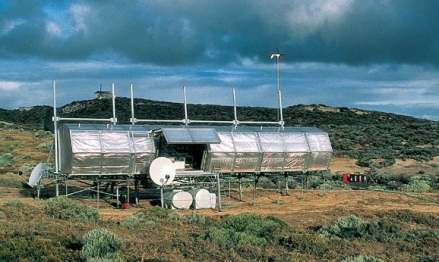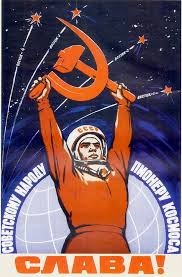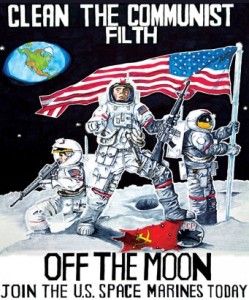How space research influences art concepts.
In the first reading, “Coded Utopia,” the article talked Makrolab, about the art of transition. Khlebnikov built a complex system that changed the language and the basic unit of thought. It is said that this may serve as a code or a matrix for all the activity at the end of this century when we are facing a tectonic movement in the social spheres. This article talks about art becoming an experimental territory for producing subjectivities. The Makrolab relates to these artistic subjectivities by the exterior. For example, the futuristic design including the aerials and sensors. Not only is the exterior a relation to art, but it also has a deeper meaning. The Makrolab can also suggest a model of social evolution developed in Guattari’s complexity theory. The Makrolab creates this by integrating the deterritorializing force of scientific formulas and artist ideas into the experimental level. This includes the artistic forms from a wide variety of projects that fit together. For example, it includes military cultures of transnational capitalism and the loosening up subjectivity, and a variance with dominant patterns.

Relating this idea of space and art integrating, is the space race propaganda between the USA and the URSS. Thinking back, this space race was a matter of posters and propaganda to intimidate others of their progress. In the article I researched, “Space Race Propaganda: USA vs. URSS. A Matter Of Posters,” it talks about how millions of scientists and science finatics are made aware of discoveries and progress almost live, with the use of propaganda, videos, and posters that give out the latest information. This so-called Space Race was the turning point in the scientific field that took communication to the next level to inform human knowledge all over the world. The Space Race was a battle of ideologies between the URSS and USA at that time to emerge at the end of World War II.

In the poster above, in the literary sense, the public could see that the globe, which was recognizable by the meridians and parallels signed, surrounded by outer space. The man is also in a triumphant pose (a Soviet cosmonaut) representing Soviet power and superiority. It is said that he cannot be recognized because he is not a specific person, but he represents the community as a whole. This poster is related to the scientific idea of space and art integrated to portray its scientific discoveries on the rest of the world.

This image above is to represent the Americans turn to issue a victory poster to show the world. The message that comes out of this poster shows American superiority over the Soviets forces, who had failed in their endeavor. This image celebrates a Man’s landing on the Moon. This poster includes an aggressive tone, with the three astronauts standing in a warrior-like position after their victory on the battlefield in the scientific field.
Each nation tried to show their dominance by utilizing different propaganda artistic ideologies through out the battle. The artistic and space related methods integrated to produce communication through out the world to acknowledge people around the world.
Works Cited:
"CODED UTOPIA." Continental Drift. 2007. Web. 27 May 2016.
History.com Staff. "The Space Race." History.com. A&E Television Networks, 2010. Web. 27 May 2016.
"Space Race Propaganda_G Pallotta_poster 4 - Paola Casoli Blog." Paola Casoli Blog. Web. 27 May 2016.
"The Space Race." The Cold War. 2013. Web. 27 May 2016.
Uconlineprogram. "8 Space Pt1 1280x720." YouTube. YouTube, 2013. Web. 27 May 2016.
No comments:
Post a Comment